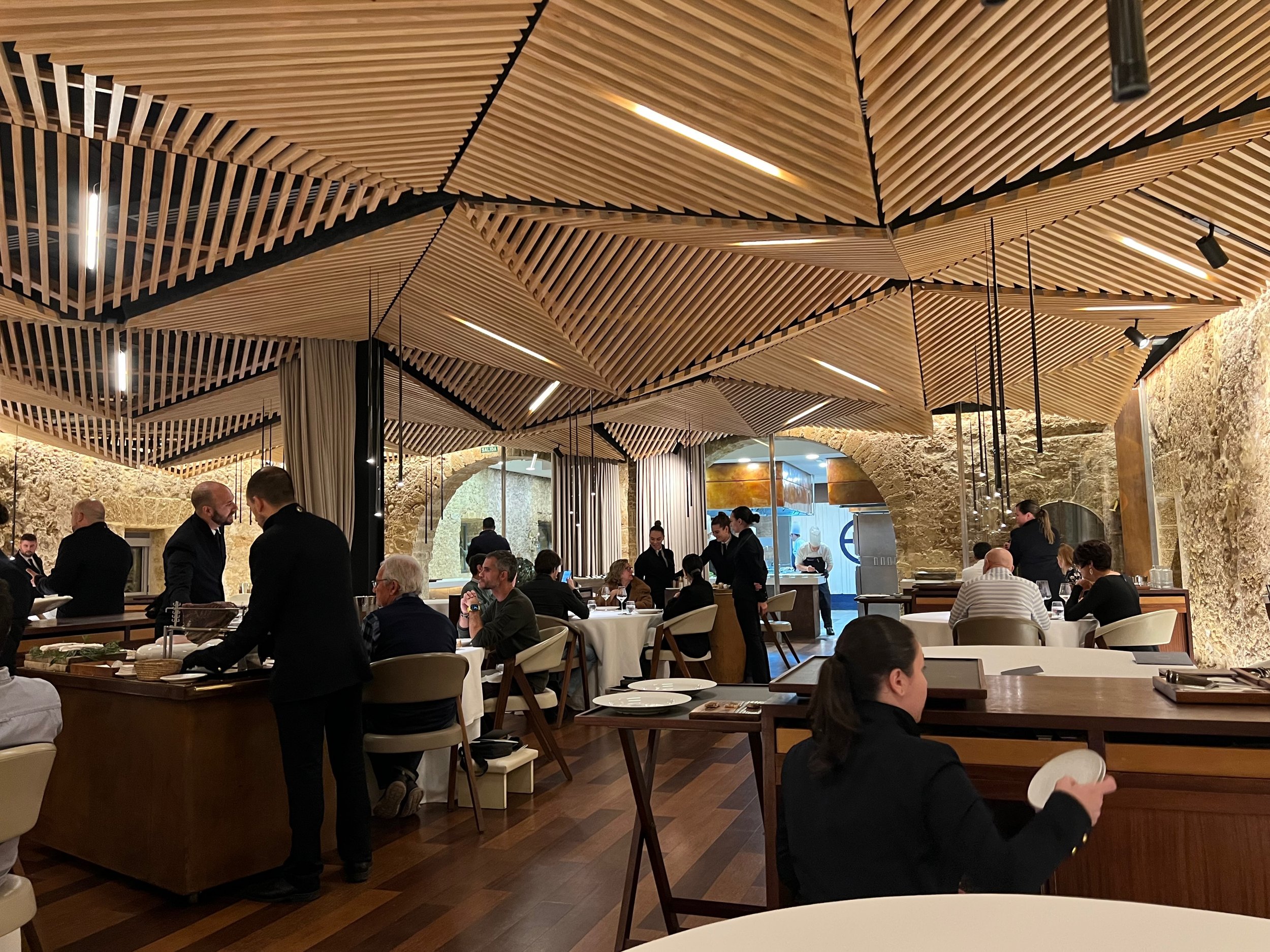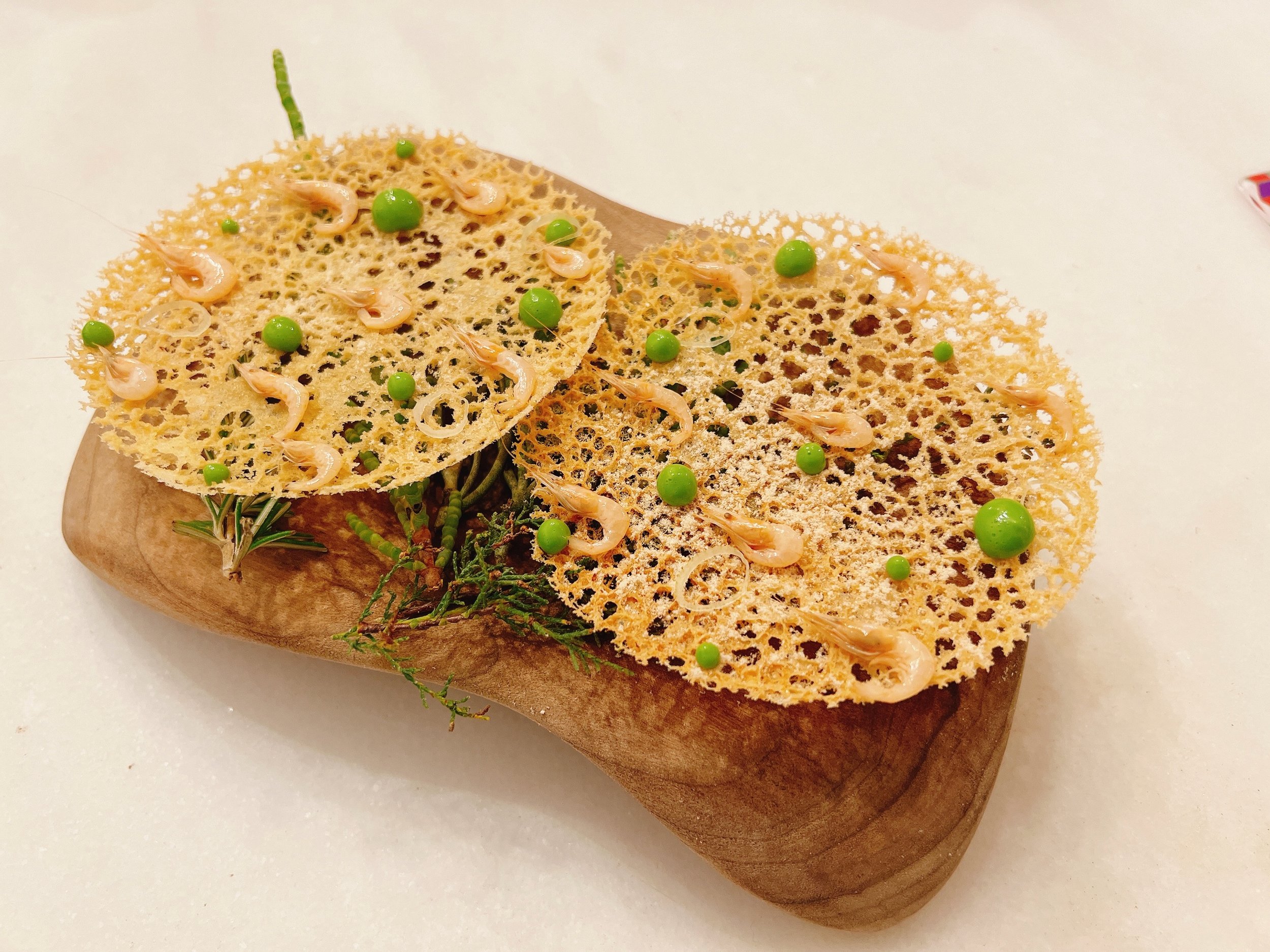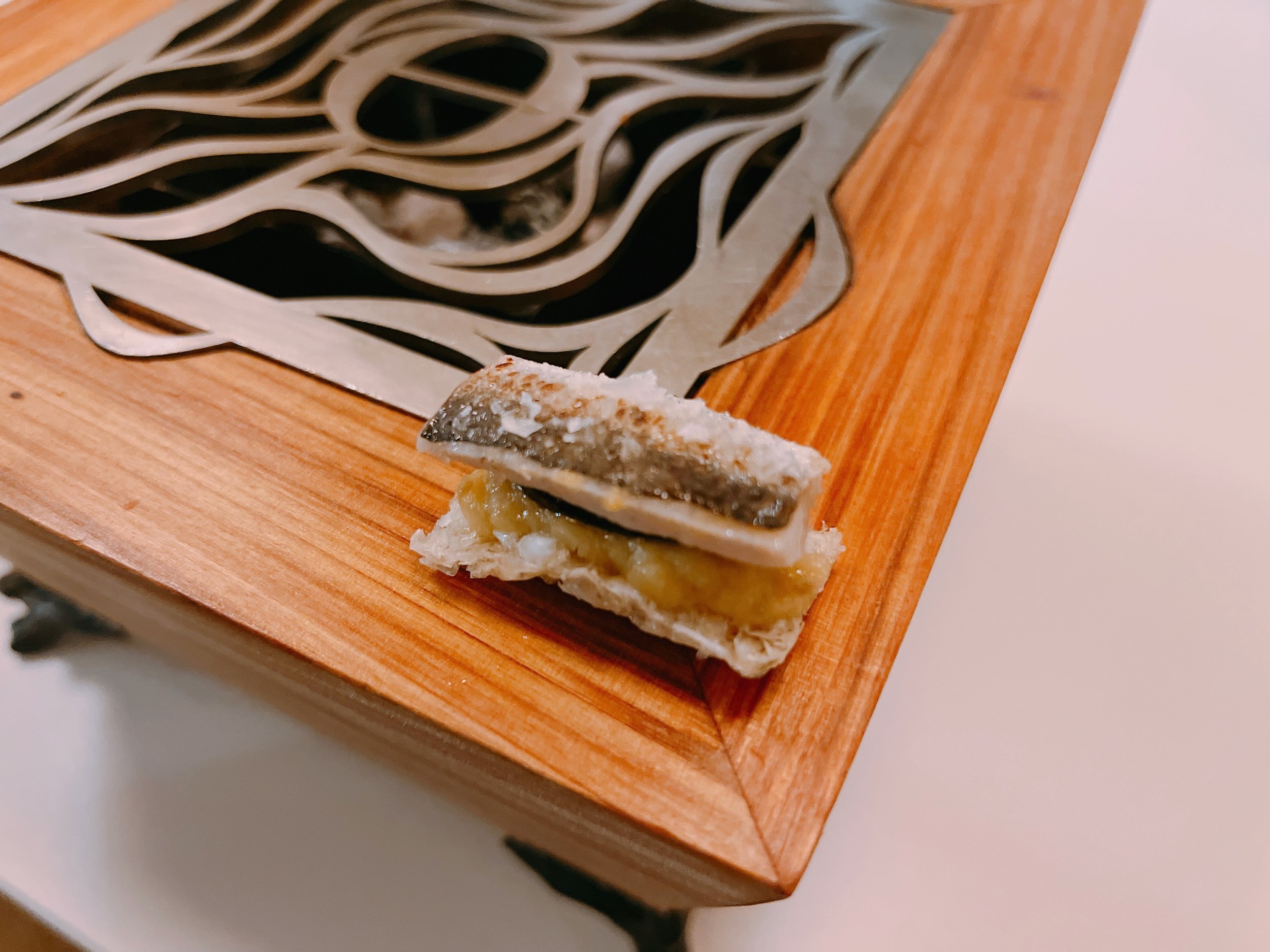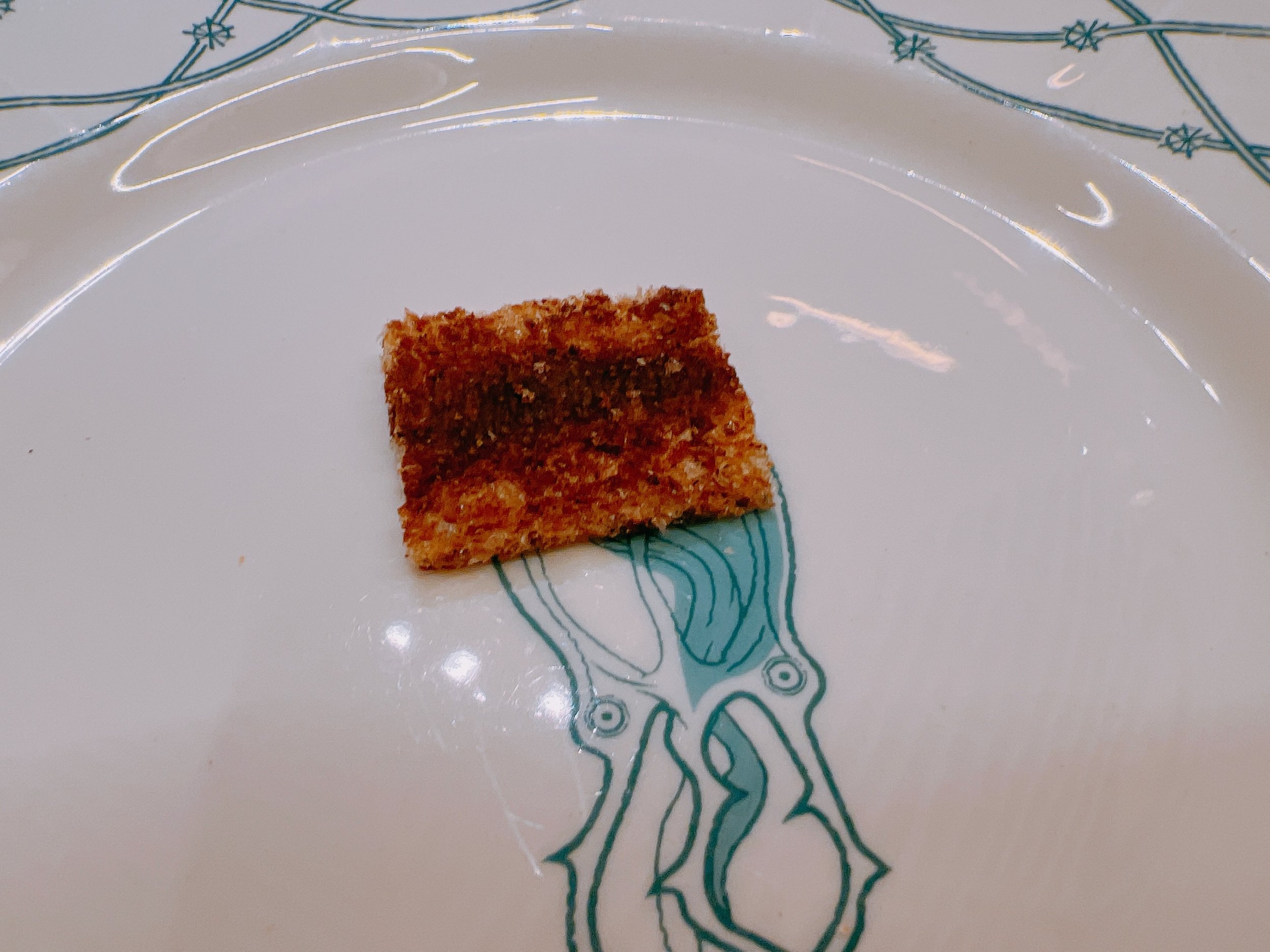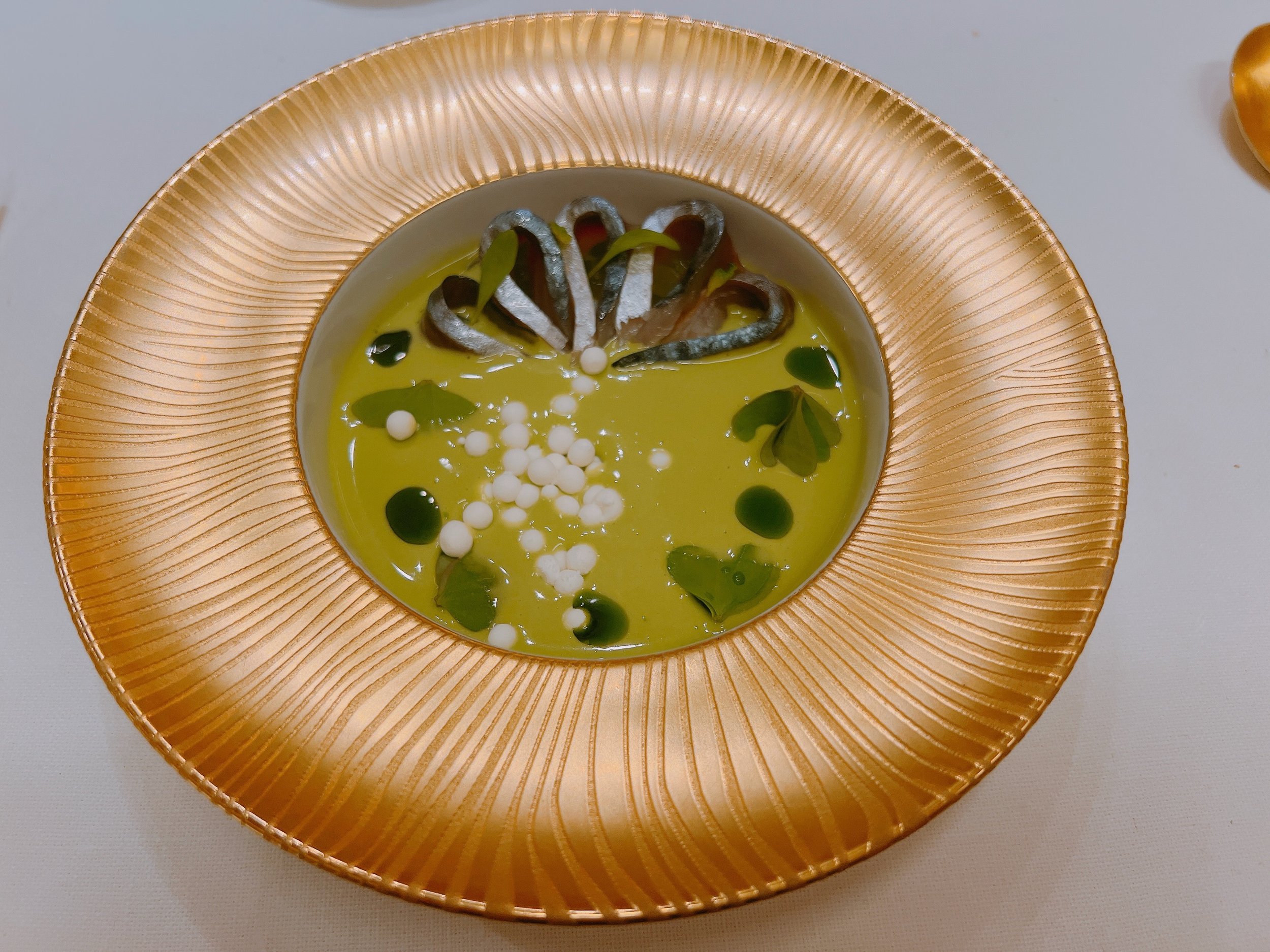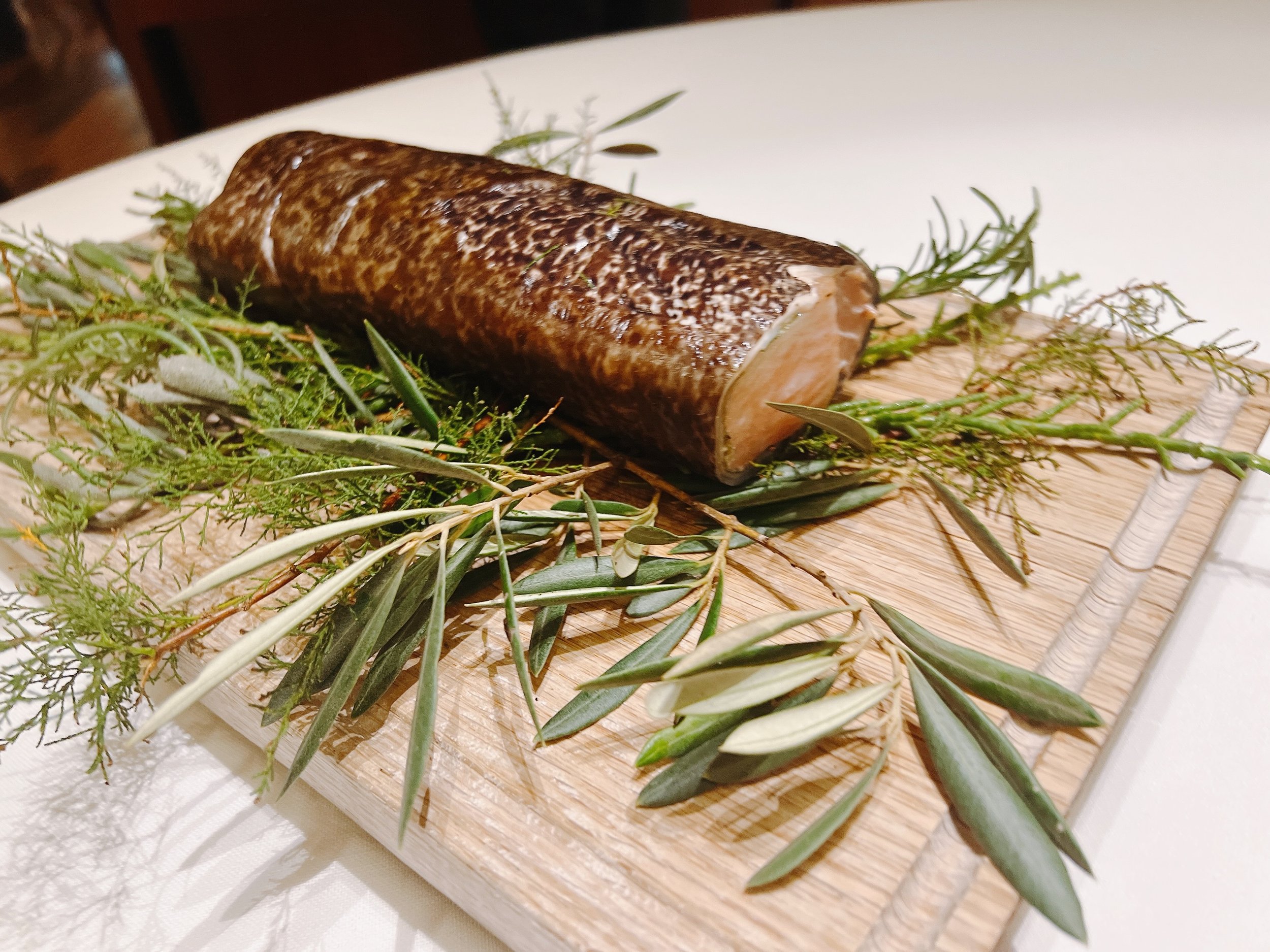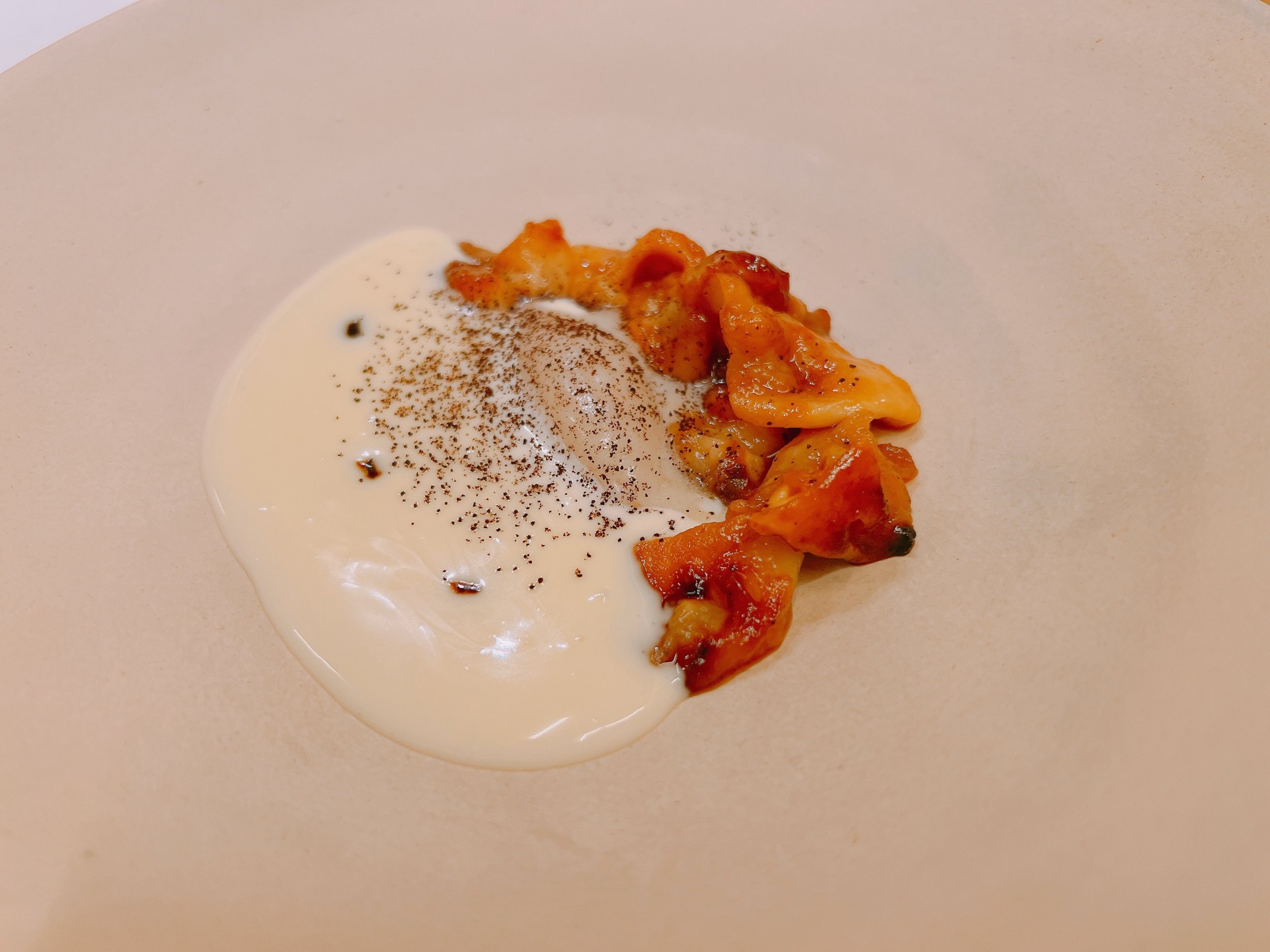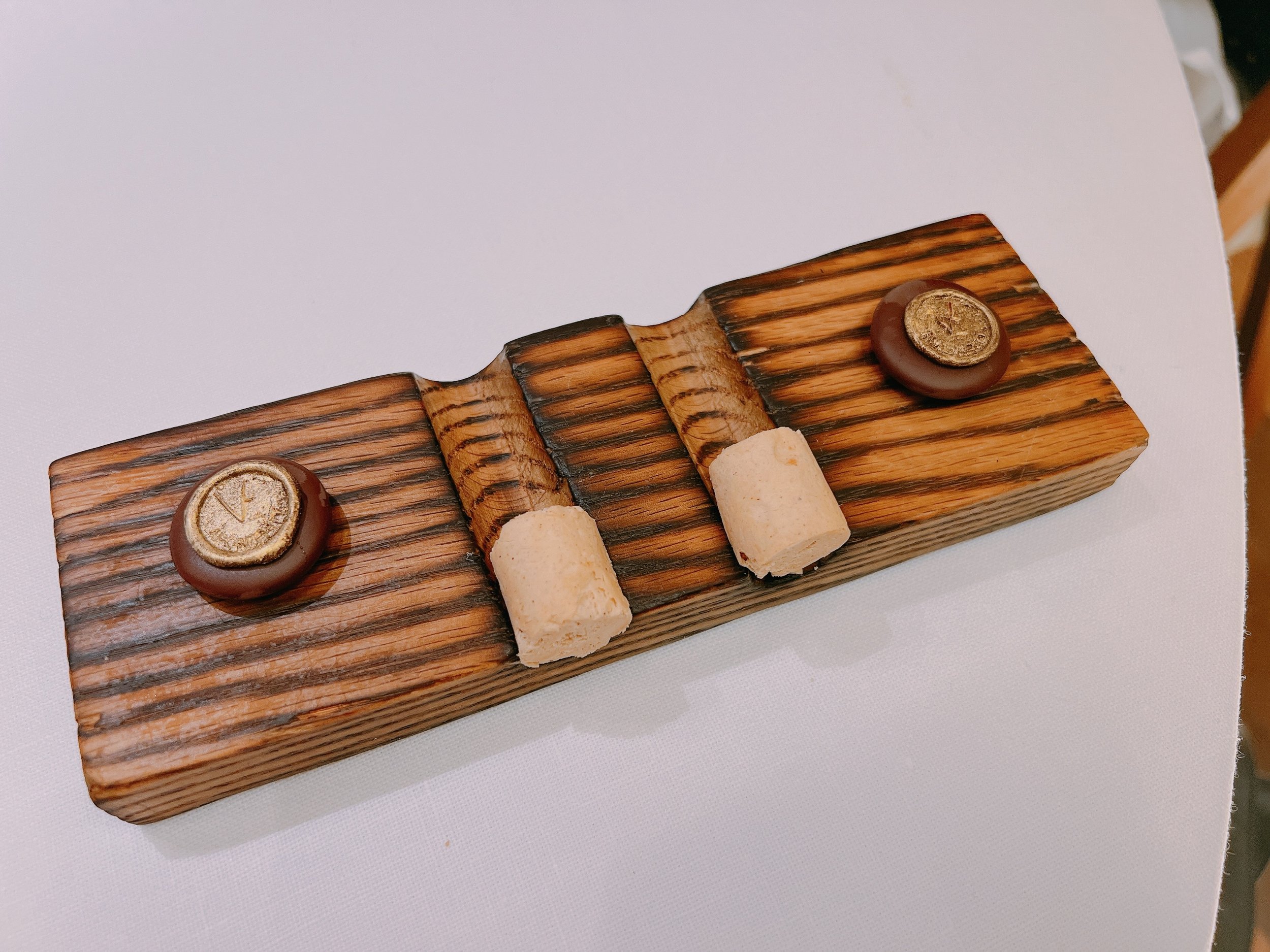Aponiente - El Puerto de Santa Maria
Rating: 17/20
Where: El Puerto de Santa Maria, Spain
When: Dinner for 2 on 6 December 2022
Cost per Person: Tasting menu 270 Euro, Wine Pairing 125-195 Euro
Accolades: 3 Michelin Stars
Why: An intellectually and technically impressive menu made from ingredients (almost) entirely from the sea
The almost full moon was our only light when walking the streets of an industrial neighborhood that was completely deserted in the evening. Passing through a dark underpass, we figured that this is the kind of place where people get killed in crime novels. Maybe we should have taken a taxi. Too late now - time to press on to reach our next dinner reservation.
How did we get here? It was the midpoint of a crazy trip through Europe that hit eight Michelin three-star restaurants in ten days. That endeavor was complicated by the fact that those eight restaurants were nowhere close to each other (or close to any major city for that matter). Case in point, our one night sojourn in the small town of El Puerto de Santa Maria on Spain's southern coast. We arrived here after a flight from Frankfurt to Seville, followed by a one hour drive. The much later sunset and more balmy temperatures compared to frosty Germany led us to the questionable decision to walk to the restaurant instead of calling a taxi. (Well, and there's saving 5 Euro or so.)
Our goal: Aponiente, Europe's southern-most restaurant with three Michelin stars. The restaurant's location somewhat outside the town center is explained by the history of its main building. It used to be a mill that utilized the incoming and outgoing tides to power its millstones. Hence the location on a pier jutting over water connected to the ocean.
Not that anyone would think the restaurant looks like a mill, it has been completely renovated in a contemporary style, and additional buildings have been added to form a whole dining complex. Our dinner took place in two different locations on the premises. Appetizers were served in a modern lounge right next to the metal doors that form the entrance to the restaurant's grounds. We were seated at a communal table in low chairs, and the ambiance definitely said more lounge than fine-dining restaurant. Later, we progressed on to the main dining room that was located in the historical mill building. The mill’s interior had been redone in a modern decor with white table cloths, but kept the rustic stone walls (see picture above).
Being this close to the sea wasn't just a nice backdrop. The restaurant's goal was to serve a meal that was pescatarian, but not just that: ingredients were sourced almost exclusively from the ocean. Not salad, but seaweed, not dairy, but elaborate seafood-based replacements, etc, you get the idea. If I scored ambition alone, then this restaurant would deserve a 20/20 rating. But let's go through the dining experience first.
The restaurant was tasting menu only, so there were no food-related decisions to be made. Two wine pairings were on offer, one with only local wines at 125 Euro, the other with wines from around the world for 195 Euro. At the recommendation of the sommelier I went for the latter, and received generally decent wines. One of the dessert wines was truly spectacular, ironically it turned out to be a local wine.
The lack of any food choices meant that the dinner could start right after our arrival in the lounge. A complimentary sparkling wine was poured moments after we sat down - a nice touch, avoiding even having to read an aperitif menu. The first appetizer was not far behind: a squid “nigiri” topped with adobo sauce. I put the nigiri in quotes since this dish contained no rice. Instead of rice, we got finely chopped squid that resembled rice visually, but was much creamier in texture. The lovely, traditional adobo sauce added some nice flavor to the dish. Excellent 18+.
Next arrived a serving of “sea bacon”, which were actually thin slices of sea bass that had been prepared like bacon. Smoky, with umami and a texture that was a mix between lardo and bacon, this dish was also really, really good. A small almond date praline was served next to it: crunchy and very sweet. It was also very nice, but probably meant mostly as a palate cleanser after the relatively fatty bacon 19.
A thick blini was topped with uni and a brown butter foam. This was my least favorite among the appetizers, with the blini too sweet and too cakey, and I sadly couldn't taste the uni at all 15.
Our last appetizer in the lounge was a Spanish “omelet” with baby shrimp and dollops of parsley emulsion. The omelet didn't come in the expected form, but was a large thin cracker that thankfully held together pretty well when eaten in multiple bites. The dish overall was pretty salty, but otherwise quite enjoyable - with a nice crunch, a good seafood flavor and a wonderful freshness from the herbs 19.
At this point, we were led to the main building of the complex. A brief tour of the old mill and the wine cellar led to another food station. Standing at a counter we were poured another complementary glass of wine, and served a tiny “sandwich” made from sardine scales and filled with eggplant and sardine. A lovely appetizer - salty, fishy and a bit fruity from the eggplant 19.
Led past the open kitchen, we finally arrived at our dining table, where the rest of the dinner would take place. During our meal, we were served three different kinds of bread, a sourdough, a bread with spelt, and a local brown bread. All were served as warm slices, and all had excellent crusts. It was hard to stop eating them, I particularly liked the brown bread. An accompanying butter seasoned with plankton was also very good 18.
Our meal began with “ham and cheese” - but these were unlike any ham or cheese I'd previously encountered. To start, they were neither. The "ham" was made from tuna belly that had been cured for forty days similar to a pork leg. Our server remarked on how much longer the curing of pork took. The end result was very tasty and salty, and felt like a mix between tuna and jamon. There could be no mistaking this for true jamon, but it was excellent nevertheless. Then, the “cheese”. Looking in vain for milk in the ocean, the kitchen settled on milt instead (off by only one letter, I suppose). This resulted in cheese made from tuna milt (and a tiny bit of cow's milk) that had been aged for one week. We were told that the milk was necessary to get a more cheese-like consistency - not for lack of trying to do without it, I'm sure. The milk cows of the world can relax, they are not out of a job quite yet. The consistency of the cheese was similar to Camembert, it was creamy, somewhat bitter, and had a really funky aftertaste. Interesting, but I doubt that this will make a big splash at the cheese counter anytime soon. Still, an interesting and fairly successful experiment. On the side, we received a small cracker that had been made from the skin of sea cucumber. It was very crispy, with a taste reminiscent of a shrimp chip. All together 18.
Next, a salad, and again, looks were deceiving. The salad “leaves” were seaweed, and the sauce that looked and tasted as if it contained dairy, yogurt say, consisted solely of maritime ingredients - amazing! It was made from oysters, oyster water and a thickening collagen extracted from sea bass scales. I loved the sauce and the delicate seaweed flavor, but I have to admit that this dish was very, very salty, so beware 19.
Lightly cooked shrimp were served with a variant on a roteña sauce, in this case made of tomatoes, pepper and garlic. Several oils - I recall bitter orange being mentioned - and a slice of chestnut completed the dish. The soft chestnut really only added a bit of texture, and no taste. But the sauce was very nice, and went well with the soft shrimp 18.
Two preparations of sea snail arrived next. The first one was titled “texture” and made from the snail's tendons. Served on a twig, it was nicely seasoned, with a hint of fir. Salty, and chewy in a good way, this was a delightful bite. The second preparation of sea snail used the snail’s insides: sea snail meat was topped with seaweed cream and seaweed powder. The dish was called “flavor”, and was bursting with it. Very seafoody, but also very salty, it was actually best when eaten as a condiment to the excellent bread. That approach mitigated the saltiness somewhat 18.
Mackerel had been cured in fig leaves and salt for two days, and was served raw with an escabeche. Also on the plate were diced cucumbers, spring onion oil, and little frozen balls of horseradish cream. The fish was good, and the cucumbers added some nice texture, but both the sauce and the cucumbers were oddly sweet - I would have preferred a more savory dish 17.
We had encountered oysters as part of the salad sauce before, but now came the real deal. A large oyster was served in a Basque cream sauce with parsley and green peas. The peas had been grown in salt water, which gave them a unique, lovely flavor and a nice crunch. The sauce was also very good, fresh and green tasting (yes, “green” was indeed the flavor that came to mind). The oyster had been lightly cooked resulting in a slightly creamy texture, but not too much flavor. Not my favorite oyster - the rest of the dish was actually better 17.
Baby hake that had been cured in salt was served with a sauce of garlic, vinegar and local peppers. On its side was a little of sea asparagus. A very pretty, and also quite delicious dish. The delicate fish had been cooked perfectly, the sauce was tasty and light, balanced just right in order not to overpower the fish. The sea asparagus added some nice crunch 18. My dining companion would have given this a 19.
It was already time for the savory main course, a seafood version of porchetta. The meat here was tuna, but it was wrapped in layers of other ingredients to obtain a crunchy “skin”. These layers included moray eel skin, the sea bass “bacon” from the very beginning of the meal, eel roe and monkfish liver. The dish had then been cooked to a (quite) well done consistency, so it was next to impossible to distinguish the different layers in the final product. Overcooked tuna is not really my favorite, and this dish ended up being very heavy and very fatty. The skin was indeed very crunchy (besides being fatty). I was pining for the lightness and delicate flavors of the previous courses - this was just too rustic and a flavor muddle 16. (For comparison, we had a superior version of seafood porchetta at Osteria Francescana a few months earlier.)
On to desserts: charcoal grilled pieces of custard apple were served with a broth of charred fish bones and lemon. The fruit was nice and sweet, and the sauce almost savory with a hint of citrus. Fruit and sauce were fine by themselves, but the combination didn’t really work for me. An interesting experiment, but a just ok result 16. (For the gold standard in adding fish to a dessert, see our visit to Christopher Coutanceau earlier in the year.)
Next came a reimagination of an apple tarte tartin that used kombu (seaweed) instead of the tarte's base and crust. This was pretty much a sandwich made of seaweed leaves, and filled with apple. On the same plate was a dollop of croissant ice cream. This ice cream was indeed great, very sweet and flavorful (19 by itself). The tarte was fine, but also weird, and sadly entirely without the crunch that makes a real tarte tartin so delicious. Overall 16.
Petit fours based on sherry (“the” local wine) showed quite a variety. A grape filled with sherry (I think) was good, but pretty light in flavor 16. A marshmallow had been made from the yeast layer that forms on the top of sherry during production. Not unsurprisingly, the result tasted very yeasty, a bit sweet, and somewhat odd 15. Chocolate truffles had been seasoned with different kinds of sherry. These were harmless (good, but not amazing), and I couldn't really taste sherry in any of them 16. My favorite bite was a “cork” made from hazelnuts and white chocolate, it had a nicely light flavor 17. Finally, a chocolate praline was filled with caramel made from a local vinegar that's similar to balsamic vinegar. The balance felt a bit off here, the praline was too vinegary 16.
The dinner concluded with a “jellyfish sting”. This was a jelly made from red fruit, kombucha, and a bit of a numbing agent (I didn't catch the details). A nondescript jelly after which the tongue indeed turned a bit numb. Good that this wasn't served earlier 15.
The service throughout dinner was very good. In particular the relaxed way of starting the dinner right away with complementary wine and appetizers was fantastic. No waiting and reading of menus, we were able to just sit back and enjoy.
A small nitpick: during the main part of our dinner, the timing of the courses could have been better. Sometimes, there were long waits between dishes, at other times, they arrived in very short succession. Slowing these spurts down a bit would have improved the dining experience. But other than that, all was positive. Our server was very observant: when she noticed that my dining companion didn't finish a dish of raw shrimp, she proactively offered to fully cook all of the following raw dishes. And when asked for an off-menu hot chocolate at the end of dinner, the kitchen managed to create one from scratch using milk and chocolate that were meant for other dishes - kudos! (Trying this the following night just got us a “we don’t have that.”)
Overall: A cook-from-the-sea tour-de-force, this was an intellectually very impressive dinner. I've rarely seen the ambition to use this many ingredients from the sea and recreate dishes that would be easy to make with land-based products, but required quite some sophistication to do so without.
It's hard to rate this restaurant objectively, since it depends a lot on what you are looking for in a dinner. From an intellectual point of view, to see what a “true” pescatarian (maritime?) menu can look like in the hands of a single-minded world-class kitchen, it's easy to rate this restaurant a 20. Any die-hard foodie will find the result most interesting and probably more memorable than many other three star restaurants. I'm definitely very happy that I went.
However, I generally rate restaurants only on how good the food tasted, and that's where Aponiente falls a bit short. The menu started strong, but the later courses went from simply delicious to more ambitious, a bit weirder and generally not as satisfying.
This restaurant is the culinary equivalent an Oscar-caliber art house movie: beloved by critics who go to movies so often that they are bored by anything that's “only” entertainment. But most of us are not as jaded, and would rather go for just a good time. Same here: this restaurant is great for hard-core foodies, but maybe not the best choice for someone looking for “just” a delicious dinner 17.
